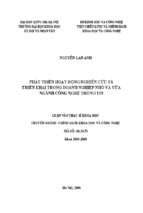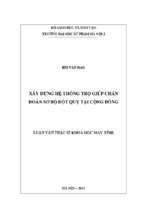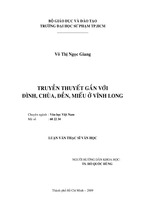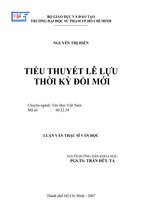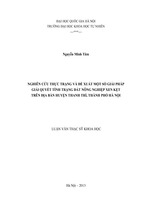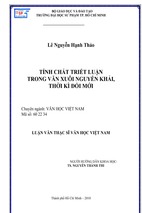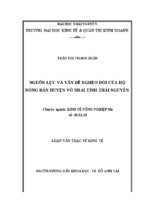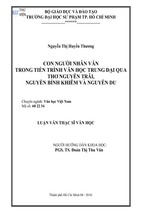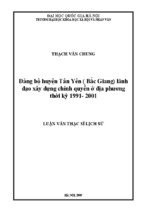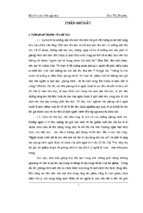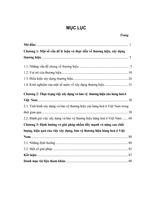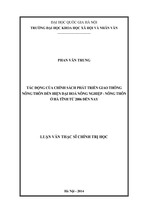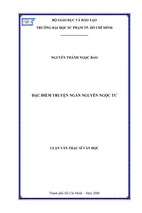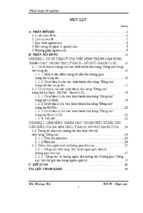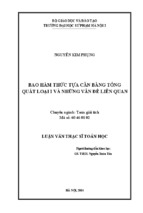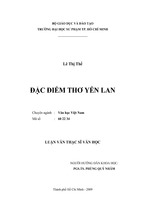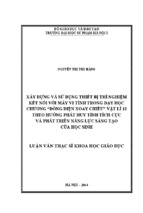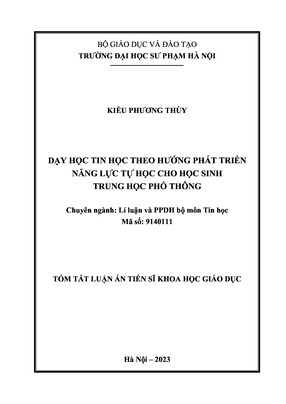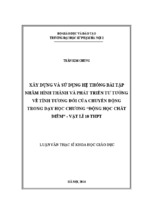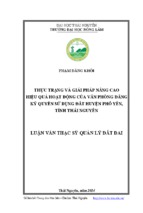Regarding the importance of intercultural competence in second language acquisition, progressive scholars today believe that culture and language are inseparable and culture elements must be an integral part of language learning. Admittedly, language is a means of transporting culture and cultural elements present in every aspect of language. Mastering a target language means to understand its distinctive culture. It is a commonly held belief that the integration of target cultural knowledge into lessons have had positive effectiveness on enhancing student’s awareness of culture. This action research project applied a trial intensive speaking course specifying the eight stated British cultural elements. Consequently, the applied cultural teaching techniques together with productive students’ speaking practice activities widened students’ knowledge of British culture. The intercultural communicative competence of students, to some extent, has been improved
VIET NAM NATIONAL UNIVERSITY, HA NOI
UNIVERSITY OF LANGUAGES & INTERNATIONAL STUDIES
FACULTY OF POST – GRADUATE STUDIES
*****************
HOÀNG THỊ THU GIANG
AN ACTION RESEARCH PROJECT ON ENHANCING STUDENT’S
AWARENESS OF BRITISH CULTURE IN SPEAKING LESSONS AT
A SECONDARY SCHOOL IN QUANG BINH
(Nghiên cứu hành động về việc nâng cao nhận thức của học sinh về Văn hóa
Anh quốc trong giờ dạy nói ở một trường trung học cơ sở tại Quảng Bình)
M.A. THESIS
Field
: English Teaching Methodology
Code : 8140231.01
Hanoi – 2020
VIET NAM NATIONAL UNIVERSITY, HA NOI
UNIVERSITY OF LANGUAGES & INTERNATIONAL STUDIES
FACULTY OF POST – GRADUATE STUDIES
*****************
HOÀNG THỊ THU GIANG
AN ACTION RESEARCH PROJECT ON ENHANCING STUDENT’S
AWARENESS OF BRITISH CULTURE IN SPEAKING LESSONS AT
A SECONDARY SCHOOL IN QUANG BINH
(Nghiên cứu hành động về việc nâng cao nhận thức của học sinh về Văn hóa
Anh quốc trong giờ dạy nói ở một trường trung học cơ sở tại Quảng Bình)
M.A. THESIS
Field
: English Teaching Methodology
Code : 8140231.01
Supervisor : Huynh Anh Tuan, Ph.D
Hanoi – 2020
DECLARATION
I, Hoang Thi Thu Giang, certify my authorship of the MA thesis entitled “An
action research project on enhancing students’ awareness of British Culture in
speaking lessons at a secondary school in Quang Binh” The substance of the MA
thesis has not, wholly or in part, has been submitted for a degree in any other
university or institution.
Hanoi, July 2020
Hoang Thi Thu Giang
i
ACKNOWLEDGEMENTS
On the completion of this MA thesis, I would like, first of all, to express my
deepest gratitude and indebtedness to my supervisor- Dr. Huynh Anh Tuan who has
always been most willing and ready to give me valuable advice, inspiration and
supervision.
I also wish to express my sincere thanks to the teachers of English and students
in the secondary school in Quang Binh for their great assistance and support during
the process of conducting this MA thesis, without which my thesis cannot have
been accomplished.
It is a big mistake if I would not acknowledge here my special thanks to the
authors of methodology and cultural works whose ideas have inspired and
stimulated my thinking and my writing of this thesis.
Ultimately, I would like to give my heartfelt thanks to my family, my friends
for their encouragement and inspiration.
This MA thesis has been completed to my best knowledge, however, mistake
and short-comings are unavoidable. Hence, I look forward to receiving
comments and suggestions from teachers, students and any readers, for the
perfection of the thesis.
Hanoi, July 2020
Hoang Thi Thu Giang
ii
ABSTRACT
Regarding the importance of intercultural competence in second language
acquisition, progressive scholars today believe that culture and language are inseparable
and culture elements must be an integral part of language learning. The study aims to
investigate the extent to which the applied techniques of teaching culture enhance
the students’ awareness about British Culture. It also explores the students’ attitude
towards the applied techniques. The eight stated cultural elements in the intensive
course, the typical technique of teaching culture, namely cultural practices together
with supportive activities like presentation, group works and role play have been
proved effectively after the project. The most noticeable merit for students is that
they could have more opportunities to enhance their awareness of British Culture in
speaking lessons via many cultural experiences. They showed their positive attitude
towards the course. The research concludes that enhancing students’ awareness of
culture of the target language is new to the teaching context in Quang Binh. It
should be widely introduced to secondary schools there for such kind of methods
directly and highly benefit the teaching and learning English.
iii
LIST OF FIGURES AND CHARTS
Figure 2.1. The cultural iceberg ........................................................................................... 7
Figure 3.1: Types of action research .................................................................................20
Chart 4.1: Percentage of correct answers in Pre Intervention test ...................................28
Chart 4.2: The data of questions 1 in the pre-intervention test ........................................29
Chart 4.3: The data of questions 2 in the pre- intervention test .......................................30
Chart 4.4: The data of questions 3 in the pre- intervention test .......................................31
Chart 4.5: The summary of opened questions number 4 in the pre-intervention test .......33
Chart 4.6: Percentage of correct answers for three closed questions in the posttest ......36
Chart 4.7: The summary data of the opened questions in the posttest ............................36
Chart 4.8: The data of correct answers in closed questions of the pretest and posttest .37
Chart 4.9: The percentage of correct answers to questions number 2 & 3 in the posttest... 38
Chart 4.10: The data of opened questions number 4 of the pretest and posttest ............39
Chart 4.11: The data of the presentation part ....................................................................40
Chart 4.12: The data of the practice part ...........................................................................41
Chart 4.13: The data of the production part ......................................................................41
Chart 4.14: The summary data of the event observation .................................................42
Chart 4.15: The summary data in the questionnaire.........................................................43
Chart 4.16: Further information from students in the questionnaire ...............................45
LIST OF TABLES
Table 4.1: Methods to enhance the students’ awareness of British Culture ...................34
iv
ABBREVIATIONS
(in Tables and Charts)
- DoE - The Duke of Edinburgh Award
- BSC - The Bog Snorkelling Championship
- FH The Fox- hunting
- HF - Halloween festival
- Chs - Christmas
- LoRH - The Legend of Robin Hood
- W.Sh - William Shakespeare
- ThB - The Beatles
- CQ - Closed question
- OQ - Opened question
- RH - Raising hand
- BA - Being attentive
- FT - Finishing the task in time
- CA - Correct answer
- PGA - Participating in group activities
- V - Volunteering to make presentation
WC/D - Wearing custumes/ disguising
BAtV - Being attentive to the video
JG/D - Joining the games/ dance
v
TABLE OF CONTENTS
DECLARATION................................................................................................................. i
ACKNOWLEDGEMENTS .............................................................................................ii
ABSTRACT ...................................................................................................................... iii
LIST OF FIGURES AND CHARTS .............................................................................iv
LIST OF TABLES ............................................................................................................iv
ABBREVIATIONS ............................................................................................................ v
TABLE OF CONTENTS .................................................................................................vi
CHAPTER: I INTRODUCTION .................................................................................... 1
1.1. Rationale ........................................................................................................................ 1
1.2. Aims and Objectives ..................................................................................................... 2
1.3. Research questions ........................................................................................................ 3
1.4. Scope of the study ......................................................................................................... 3
1.5. Methods of the study ..................................................................................................... 4
1.6. Significance of the study............................................................................................... 4
1.7. Structure of the thesis .................................................................................................... 5
CHAPTER II: LITERATURE REVIEW ..................................................................... 6
2.1. Culture and language teaching ..................................................................................... 6
2.1.1. Culture and its components ....................................................................................... 6
2.1.2. The relation of culture with cross-cultural, inter-cultural communication ............. 8
2.1.3. Importance of culture in language teaching ............................................................. 9
2.2. An overview of Teaching Speaking and Teaching Culture .....................................10
2.2.1. Goals of teaching culture in language classes ........................................................10
2.2.2. Classroom speaking activities .................................................................................11
2.2.4. Applying cultural teaching techniques in speaking lessons ..................................14
2.2.5. Some productive guidelines for teaching culture ...................................................15
2.3. Review of previous studies related to the research area of the thesis ......................16
CHAPTER III: METHODOLOGY .............................................................................18
3.1. Research approach: Action research ..........................................................................18
vi
3.1.1. Why Action research? ..............................................................................................18
3.2. An action research project ..........................................................................................21
3.3. Research context..........................................................................................................24
3.4. Data collection instruments ........................................................................................24
3.4.1. Tests ..........................................................................................................................24
3.4.2. Observation...............................................................................................................25
3.4.3. Questionnaire............................................................................................................25
3.5. Data collection procedure ...........................................................................................25
3.6. Data analysis procedure ..............................................................................................26
3.6.1. Quantitative analysis ................................................................................................26
3.6.2. Qualitative analysis ..................................................................................................27
CHAPTER IV: FINDINGS AND DISCUSSION .......................................................28
4.1. The extent to which the applied techniques of teaching culture enhance the
students’ awareness of British culture ...............................................................................28
4.1.1. General pretest findings ...........................................................................................28
4.1.2. Applied teaching techniques and practicing activities ...........................................33
4.1.3. Initial information of posttest ..................................................................................35
4.2. The students’ attitudes towards the applied techniques ............................................39
4.2.1. Observation interpretation .......................................................................................40
4.2.2. Questionnaire interpretation ....................................................................................43
CHAPTER V: CONCLUSION......................................................................................46
5.1. Recapitulation ..............................................................................................................46
5.2. Concluding remarks ....................................................................................................46
5.3. Limitation.....................................................................................................................48
5.4. Suggestions for further studies ...................................................................................48
5.4. Reflection .....................................................................................................................49
REFERENCES .................................................................................................................51
APPENDICES .....................................................................................................................I
vii
CHAPTER: I INTRODUCTION
Knowledge of the world’s languages and cultures is more vital than ever. In
order to compete in the global community, we must be able to communicate
effectively and to appreciate, to understand and to work effectively in the
framework of other cultures. It seems obvious enough that to penetrate another
language, one must understand what its people are saying and make oneself
understood.
1.1. Rationale
One naive assumption occasionally made by teachers is that a mastery of the
linguistics patterns of a foreign culture leads itself to “thinking like a native”. As
Lewald (1968) properly points out, this belief is unwarranted. Unless the student is
learning the language in the target culture, the cultural referents necessary to
understanding a native speaker must be learned in addition (cited in Seelye, 1974).
Learning a language in isolation of its cultural roots prevents one from
becoming socialized into its contextual use. Knowledge of linguistics structure
alone does not carry with it any special insight into the political, social, religious, or
economic system.
Today, for educators and teachers of English, the culture of target language has
been put much consideration in second language teaching. The expected outcomes,
however, seem to be far from satisfactory.
Although aware of the role of culture as the key to a success in second language
acquisition, there are times when it is difficult for a guest in a new culture to adapt
the cultural norm of the host country. As a result, sometimes, the terms culture
shock or conflicting value systems have been much mentioned for appropriate
explanation of the failure in communication and social interaction.
The way success works is not really easy to discover. Obviously, the culture
elements have not been thoroughly exploited in language lessons. To be purposeful,
teaching activities should integrate cultural elements in a reasonable way. In other
1
words, teacher as an instructor must be purposeful to lead learners to somewhere. It
should be apparent- at least to the instructor- what the reason is for doing any given
cultural activities.
Fortunately, the important role of culture in mastering a second language has
been acknowledged by most teachers everywhere, yet regrettably, they have not
benefited from much studies on the What, for better understanding about culture and
the How, for further understanding on how to teach culture effectively in language
lessons, this shows a need for my research on British culture elements in language
teaching and learning.
In fact, building productive language lessons in which both ensure language
skills and nurture as well as support intercultural communication is a difficult
process for most teachers. Methodologists and experienced teachers who have skills
in working with the alterable aspects of second language acquisition often
emphasize that there is actually no list of “things to do”, no single dramatic event
that facilitate all the language lessons. Instead, as with so many of the executive
function of teaching culture, success depends on a lot of “little things” well. As a
teacher of English, this fact stimulates my ambitions to undertake the thesis entitled
“An action research project on enhancing students’ awareness of British Culture
in speaking lessons at a secondary school in Quang Binh” in order to work-out
what the so-called “little things” are so that I will enhance my students’ awareness
of British culture and simultaneously improve their speaking skills.
1.2. Aims and Objectives
These days, the distinction between content and methodology are no longer as
sharp as they previous were. How and why learners learn become as important as
what they learn. And it is the learners who are the sources of information on and
insight into educational process.
This MA thesis aims to find out the effectiveness of the applied techniques on
enhancing the students’ awareness of British culture. In order to reach the main aim,
the two objectives are given simultaneously in detail by steps. Firstly, the researcher
2
investigates the extend to which the applied techniques enhance students’ awareness
of British culture. In the intensive speaking course designed for 7th grade of the
school year 2019-2020, I would like to apply the techniques to enhance the students’
awareness of British Culture. Obviously, some typical methods of teaching culture
through speaking activities help to stimulate the motivation of students in
experiencing British Culture. Secondly, the students’ attitudes towards the applied
technique is uncovered. To make it clearer, how the students react towards the
methods is put in my deep concern through the working on the data of questionnaire
and observation.
1.3. Research questions
The research purports to address the following questions:
1. To what extent can the applied techniques enhance the students’ awareness
of British Culture?
2. What are the students’ attitudes towards the applied techniques?
1.4. Scope of the study
In the hope of fulfilling my purpose, I would like to focus on providing a set of
wide-angle viewing and understandings the close relation between language and
culture in general and findings techniques for integrating culture in language lessons
to enhance students’ awareness of British Culture.
To find out detailed information, I would like to specify my research only with
the 7th form students. At this age, students have ability of proper cognition. In
addition, most of them have high learning motivation as they have just started the
new school level. Therefore, it is easy for teacher to stimulate and enhance their
awareness of culture.
Moreover, in order to make it easy to generalize the findings in my study, the
course book is Solutions, Pre-intermediate student’s book, 2nd Edition, Oxford
University Express. Actually, this course book is used in the extensive English
lesson, namely speaking project, alongside with the new English text book of
Vietnam Ministry of Education and Training. In fact, the structures and contents of
3
the new English text book is systematic as to move from practice to theory and back
to practice in a cycle of development of understanding of the topic in each unit.
However, the culture realization is not very clear and sufficient enough to bring
essential knowledge to students.
The four language skills of listening, speaking, reading, and writing are all
interconnected. Proficiency in each skill is necessary to become a well-rounded
communicator, however, the ability to speak skillfully provides the speaker with
several distinct advantages. The capacity to put words together in a meaningful way
to reflect thoughts, opinions, and feelings provides the speaker a perfect image.
Therefore, I choose speaking lessons to conduct my study.
1.5. Methods of the study
To successfully and effectively reach the aims of the thesis, I adapt steps in
Nunan (1992)’s action research cycle. The action project was proceeded in five
main steps, namely problem identification, preliminary investigation, hypothesis,
intervention, and evaluation. Research data was collected with a number of
instruments including,
pre-test, post-test, questionnaire and observation. After a
preliminary investigation had been carried out, an intensive speaking course was
designed, and then implemented with the participation of 38 7th grade students at a
secondary in Quang Binh. After finishing the course, to gain the multiple
perspective for the study, the students were requested to finish the posttest and
questionnaire to check the outcome of the technique implement.
1.6. Significance of the study
This thesis has its significance in many ways. Firstly, the thesis would provide
information on the intensity and understanding of knowledge of language and
culture. Secondly, it will give readers and teachers significant insights about the
importance of enhancing students’ awareness of British culture. Thirdly, the thesis
has immense possibility to offer teachers with some techniques to enhance students’
awareness of British culture. The most significance is that all these benefits will
develop learners’ communicative competence in English and other areas of
language learning.
4
Furthermore, findings from the study would also be a reliable source of track
for other studies on language and culture in all major area which are involved in
learning a second language.
1.7. Structure of the thesis
Within the aforementioned scope, the thesis is divided into five chapters.
Chapter one is the introduction to the thesis. In this part, I would like to give a
glimpse at language and culture in second language acquisition, the reason to
conduct this thesis. The aims and objectives, the scope, the methods and the
structure of the thesis are also included in this chapter.
Chapter two, literature review, refers to theoretical background for further steps
of the thesis.
The next chapter is the methodology. This chapter deals with detailed
information about the research questions, the research approach, the research
context, the data collection instruments, the data collection procedure and the data
analysis procedure.
Chapter four is findings and discussion in which shows the results from the tests,
observations, questionnaire and findings discussion.
Chapter five is the conclusion which summarizes the major findings of the
thesis along with its limitations, proposes suggestions for further studies and
reflection. This part gives an overview of the results and assists them in recognizing
the significance of the thesis.
5
CHAPTER II: LITERATURE REVIEW
This chapter refers to theoretical background for further steps of the thesis in
which three related areas will be presented: culture and teaching culture through
in-class speaking activities. In addtion to this, the researcher will review results of
the previous studies related to the research area, which helps the researcher have a
better understanding about the issue.
2.1. Culture and language teaching
2.1.1. Culture and its components
Culture is a far- reaching dynamic concept and an elaborate, ever-changing
phenomenon. The word culture has many different meanings. As a matter of fact, to
set precise definition for what is to be abstract and universally different perception
is sometime out of question. Personally, I adopt some ways of defining Culture as
follows:
“…that complex whole which include knowledge, belief, art, law, morals,
customs, and any other capabilities and habits acquired by man as a member of
society” (Edward B. Tylor, 1871)
“Culture is an intergrated system of learned behavior patterns that are
characteristic of the members of any given society. Culture refers to the total way of
life of particular groups of people. It includes everything that a group of people
thinks, says, does and makes – its systems of attitudes and feelings. Culture is
learned and transmitted from generation to generation” (Robert Kohls (1996)
“Culture should be regarded as the set of distinctive spiritual, material,
intellectual and emotional features of society or a social group, and that it
encompasses, in addition to art and literature, life style, ways of living together,
value systems, traditions and beliefs” (The United Nations Educational Scientific
and Cultural Organization, 2002)
“Culture is the totality of socially transmitted behaviour patterns, arts, beliefs,
institutions and all other products of human work and thought” (Peterson, 2004)
6
It can be seen that the aforementioned definitions sufficiently cover the content of
the concept “Culture”. Each definition has brought its own perspective to the way that
people think about culture. These days, the term culture has acquired new meanings
over time without losing the older meaning along the way. Knowledge based on
analyzing collected materials paves me way to interpret culture as detailed below:
Culture is a full range of learned human behaviour patterns. In other words,
culture incorporates multiple elements. Very often what people see culture is only
the surface of the culture “Comparing culture with an iceberg, that part people can
observe of others’ culture is usually the tip of the iceberg, which include the
language, architecture, food, population, music, clothing, art and literature, peace
of life, emotional display, gestures, leisure activities, eye contact and sports”
(Peterson, 2004). Below, there are still some hidden aspects like opinion,
viewpoints, attitudes, philosophies, values, beliefs, assumptions, all of which cannot
be perceived with our senses, but they are foundation for what people see at the top.
Figure 2.1. The cultural iceberg
Obviously, culture does not contain fixed rules. It varies among individuals or
societies. Learning to communicate well across cultures means being aware of the
hidden parts of the culture regarded as the submerged part of the iceberg. (Levine
and Adelman, 1992)
7
The in - depth knowledge of culture that shall be gained from the analysis of its
components. Stephen Moore (1985) claims the components of culture as the
followings:
- Beliefs: These are general, vague opinions held about the world and about the
nature of society. They vary by society and sometimes by subcultures.
- Values: These are vague beliefs about what is right and correct in the world. They
imply that there are certain appropriate forms of action which ought to be taken.
- Norms: These are socially expected patterns of behavior.
- Roles: Social roles are patterns of behavior expected of certain people
according to the occupation or position they hold in society.
- Role conflict: There are innumerable social roles. All of us occupy a number of
roles, which are generally complementary, but sometimes they may conflict.
- Status: This refer to the position of a person or social role in society according
to the amount of prestige received from others. In different societies/ cultures,
status varies.
2.1.2. The relation of culture with cross-cultural, inter-cultural communication
“Culture and communication are inseparable because culture not only dictates
who talks to whom, about what and how the communication proceeds, it also helps
to determine how people encode massages, the meanings they have for messages,
and the conditions and circumstances under which various messages may or may
not be sent, noticed, or interpreted…Culture is the foundation of communication
(Samovar, Porter & Jain, 1981, cited in Abisamra, 2009).
Crucially, speakers of different languages perceive and express the world
around them differently because of the ways in which language influences a
person’s thinking and behaviour. Language serves as a filler of its speaker’
perception and influences the way that a cultural group categorizes experience.
The term cross-culture refers to the study of a particular idea or concept within
many cultures. For better understanding, cross-cultural communication relates to a
comparison of interactions among people from the same culture to those from
8
another culture. Consequently, cross-cultural comparisons are very useful for
understanding cultural differences.
The term inter-culture, used to describe the endpoints of the continuum, denotes
the presence of at least two individuals who are culturally different from each other
on such important attributes as their value orientations, preferred communication
codes, role expectations, and perceived rules of social relationship. To make it
clearer, the term intercultural communication closely relates to the degree of
differences that can occur among people from dissimilar cultures. Intercultural
communication is specified as a symbol process in which the degree of difference
between people is large and important enough to create dissimilar interpretations
and expectations about what are regarded as competent behaviors that should be
used to create shared meaning.
Therefore, competent interpersonal communication in intercultural interactions
is a worthy and often elusive goal. Interpersonal competence is difficult objective to
achieve, as because cultural differences create dissimilar meanings and expectations
that require even greater levels of communication skills. Hence, for the sake of
improving language competence, the main purpose of the second language class is
to have the students’ chances to communicate with different hue of target culture.
2.1.3. Importance of culture in language teaching
It is commonly acknowledged that language and culture is closely related.
Language used in certain society reflects the values shared by the people in that
society. Precisely understood, culture finds its expression in language. Therefore,
learning a target language without familiarity with its culture remains incomplete.
Considering the importance of culture in language teaching, it is also meant the
consideration of the relation between language and culture. According to Bennet
(1993) learning a language without its culture is said to be turning people into a
“fluent fool”, or someone who speaks a language well but does not understand the
social or philosophical content of the language. Gao (2006) shares the same opinion
9
“when it comes to the realm of teaching and learning, the independence of language
learning and cultural learning is so evident that one can conclude that language
learning is culture learning and consequently, language teaching is cultural
teaching”. He means that foreign language teachers should be aware of the place of
cultural studies in foreign language classroom and attempt to enhance students’
cultural awareness and improve their communication competence.
The history of language education in Vietnam has experienced numerous
changes in what and how foreign language to be taught and learnt. In 2008, the
government of Vietnam launched a national foreign language education policy
known as “teaching and learning foreign languages in the national education system
from 2008 to 2020” (government of Vietnam, 2008). This policy advocates the
teaching and learning foreign language for communicating across culture in a
multicultural context.
2.2. An overview of Teaching Speaking and Teaching Culture
2.2.1. Goals of teaching culture in language classes
To set the light for teaching culture, Seelye (1993) present culturally relevant
skills that can be developed in the classroom. Especially, these skills are closely
related with six goals which help students to develop intercultural communication
and understanding. Further, students will develop sophistication in evaluating some
cultural elements. Below are these goals and skills:
(1) Goal 1- Interest:
The students show curiosity about other culture (or another segment or subculture of
one’s own culture) and empathy toward its members)
(2) Goal 2 - Who:
The student recognizes that role expectations and other social variables such as
age, sex, social class, religion, ethnicity, and place of residence affect the way
people speak and behave.
(3) Goal 3 - What:
The student realizes that effective communication requires discovering the
10
culturally conditioned images that are evoked in the minds of people when they
think, act, and react to the world around them.
(4) Goal 4 - Where and When:
The student recognizes that situational variables and convention shape behavior
in important ways.
(5) Goal 5 - Why:
The student understands that people generally act the way they do because they
are using options their society allows for satisfying basic physical and
psychological needs, and that cultural patterns are interrelated and tend
mutually to support need satisfaction.
(6) Goal 6 - Exploration:
The student can evaluate a generalization about the target culture in terms of the
amount evidence substantiating it, and has the skills needed to locate and
organize information about the target culture from the library, the mass media,
people, and personal observation.
2.2.2. Classroom speaking activities
Speaking skills are a vitally important method of communication. When it
comes to classroom activities, the real-life situation, authentic activities and
meaningful tasks pertinently promote communication. To develop these productive
skills, students need intensive and constant practice during the lesson. Obviously,
there are some popular speaking activities in classroom which meet the
aforementioned requirements such as pair/group work, role play, debate and student
presentation.
2.2.2.1. Pair/group work
Working in pairs/ groups is the most-loved set ups in language classroom. It is
learners working together in pair/ groups. Working with others gives students more
time and the opportunity to interact with a variety of people and learn from one
another. It also encourages cooperation which will help students get along in class
and could reduce the number of student outbursts too.
11
- Xem thêm -

